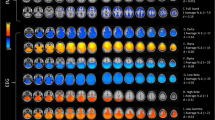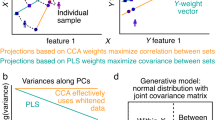Abstract
To examine the relationship between the electroencephalograph (EEG) and plasma opioid concentration, one would like to collapse the high-dimensional EEG signal into a univariate quantity. Such a simplification of the EEG is desirable because a univariate quantity can be modeled using standard nonlinear regression techniques, and because most of the information in the EEG is redundant or unrelated to drug concentration. In previous studies of the EEG response to opioids, the manner in which a univariate component was extracted from the EEG was ad hoc.In this paper, this extraction was performed optimally using a new statistical technique, semilinear canonical correlation. Data from 15 patients who received an intravenous infusion of the semisynthetic opioid alfentanil were analyzed. The components of the EEG that were nearly maximally correlated with plasma drug concentration were found, based on a standard pharmacokinetic-pharmacodynamic model. Two new EEG components were produced from the powers in the frequency spectrum of the EEG: a weighted sum of the logarithms of the powers, and a weighted sum of the powers expressed as percentages of the total power. These components both had a median R2 of 0.84, compared to median R2sranging from 0.37 to 0.83 for five commonly used ad hocEEG components. The new components also had less variability in R2 between subjects.
Similar content being viewed by others
Abbreviations
- t:
-
Time
- C E(t :
-
Effect-site concentration at timet
- k e0 :
-
Rate constant for drug transfer from the plasma to the effect site
- E :
-
EEG effect
- E 0 :
-
Baseline effect, when no drug is present in the effect site
- E max :
-
Maximum possible effect caused by the drug
- IC 50 :
-
Effect-site concentration resulting in an effect equal to (E 0+E max/2
- α :
-
Shape parameter
- ε :
-
Additive error
- q :
-
Number of dependent variables
- Y 1,Y 2,...,Y q :
-
Dependent variables
- γ 1,γ 2, ...,γ 1 :
-
Coefficients of the dependent variables
- p :
-
Number of independent variables
- X 1,X 2,...,X p :
-
Independent variables
- f :
-
Nonlinear regression function
- r :
-
Number of parameters off
- Β 1,Β 2,...,Β r :
-
Parameters off
- ε :
-
Additive random error
- n :
-
Number of observations
- y tk :
-
tth observation ofY k ,t=1, 2,...,n,k= 1,2,..., q
- y t (γ):
-
tth observation of the univariate response obtained as a linear combination of the multivariate response,γ 1 y t1 +γ 2 y t2 +...+γ q y tq
- x tj :
-
tth observation ofX j,t=1, 2,...,n,j=1,2,...,p
- x t :
-
The vector (x t1,x t2, ...,x tp)
- R 2 :
-
Proportion of variability in they t (γ) explained by thef(x t ;Β)
- γ :
-
MaximumR 2 estimate ofγ
- Β :
-
MaximumR 2 estimate ofΒ
- γ (j) :
-
MaximumR 2 estimate ofγ, for thejth subject
- γ :
-
Average of the (possibly renormalized)γ (j)
- Y :
-
Dependent variable (i.e.,q=1)
- p :
-
Number of independent variables, and the number of coefficients of the independent variables (i.e.,r=p)
- X 1,X 2,...,X p :
-
Independent variables
- Β=(Β 1,Β 2,...,Β p ):
-
Coefficients of the independent variables
- ε :
-
Additive random error
- n :
-
Number of observations
- y t :
-
tth observation ofY,t= 1, 2,...,n
- x tj :
-
tth observation ofX j,t= 1, 2,...,n,j=1, 2,...,p
- b=(b 1,b 2,...,b p ):
-
Estimates (not necessarily optimal) of the coefficients
- ŷ t(b):
-
Responses predicted using the estimatesb, b 1 x t1+b 2 x t2+...+b p x tp
- SSE(b) :
-
Sum of squared errors from estimatingΒ byb,⌆ n t=1[y t −ŷ t (b]2
- y :
-
Average of the observed responses,⌆ n t=1y t /n
- SST :
-
Total sum of squares,⌆ n t=1 (y t−y)2
- Β :
-
Estimate ofΒ that is least squares (minimumSSE) and maximumR 2
- R 2 :
-
Coefficient of multiple determination, 1−SSE(Β)/SST
- P :
-
Edge frequency percentage
References
R. G. Bickford. Automated electroencephalographic control of general anesthesia.Electroencephalog. and Clin. Neurophysiol. 2:93–96 (1950).
J. W. Bellville and G. M. Attura. Servo control of general anesthesia.Science 126: 827–830 (1957).
I. J. Rampil, J. A. Holzer, D. O. Quest, S. H. Rosenbaum, and J. W. Correll. Prognostic value of computerized EEG analysis during carotid endarterectomy.Anesth. Analg. 62:186–192 (1983).
J. C. Scott, K. V. Ponganis, and D. R. Stanski, EEG quantitation of narcotic effect: The comparative pharmacodynamics of fentanyl and alfentanil.Anesthesiology 62: 234–241 (1985).
N. T. Smith, C. J. Westover Jr., M. Quinn, J. L. Benthuysen, H. Dec Sliver, and T. J. Sanford Jr. An electroencephalographic comparison of alfentanil with other narcotics and with thiopental.J. Clin. Monit. 1:236–244 (1985).
I. J. Rampil and R. S. Matteo. Changes in EEG spectral edge frequency correlate with the hemodynamic response to laryngoscopy and intubation.Anesthesiology 67:139–142 (1987).
H. Schwilden, J. Schüttler, and H. Stoeckel. Closed-loop feedback control of metho-hexital anesthesia by quantitative EEG analysis in humans.Anesthesiology 67:341–347 (1987).
C. W. Long, N. K. Shah, C. Loughlin, J. Spydell, and R. F. Bedford. A comparison of EEG determinants of near-awakening from isoflurane and fentanyl anesthesia. Spectral edge, median power frequency, and delta ratio.Anesth. Analg. 69:169–173 (1989).
J. C. Scott and D. R. Stanski. Decreased fentanyl and alfentanil dose requirements with age. A simultaneous pharmacokinetic and pharmacodynamic evaluation.J. Pharmacol. Exp. Ther. 240:159–166 (1987).
J. C. Scott, J. E. Cooke, and D. R. Stanski. Electroencephalographic quantitation of opioid effect: Comparative pharmacodynamics of fentanyl and sufentanil.Anesthesiology 74:34–42 (1991).
M. E. Ausems, C. C. Hug, D. R. Stanski, and A. G. L. Burm. Plasma concentrations of alfentanil required to supplement nitrous oxide anesthesia for general surgery.Anes-thesiology 65:362–373 (1986).
A. Sidi, P. Halimi, and S. Cotev. Estimating anesthetic depth by electroencephalography during anesthetic induction and intubation in patients undergoing cardiac surgery.J. Clin. Anesth. 2:101–107 (1990).
J. E. Cooke and J. C. Scott. Theta ratio-A better correlate of anesthetic depth.Anesthesiology 65:A541 (1986).
W. H. Press, B. P. Flannery, S. A. Teukolsky, and W. T. Vetterling.Numerical Recipes in C, Cambridge University Press, Cambridge, MA, 1988, Ch. 12.
C. J. Hull, H. B. H. van Beem, K. McLeod, A. Sibbald, and M. J. Watson. A pharmacodynamic model for pancuronium.Br. J. Anaesth. 50:1113–1123 (1978).
L. B. Sheiner, D. R. Stanski, S. Vozeh, R. D. Miller, and J. Ham. Simultaneous modeling of pharmacokinetics and pharmacodynamics: Application to d-tubocurarine.Clin. Pharmacol. Ther. 25:358–371 (1979).
N. H. G. Holford and L. B. Sheiner. Understanding the dose-effect relationship: Clinical application of pharmacokinetic-pharmacodynamic models.Clin. Pharmacokin. 6:429–453 (1981).
A. V. Hill. The possible effects of the aggregation of the molecules of hemoglobin on its dissociation curves.J. Physiol. 40:47 (1910).
J. Neter, W. Wasserman, and M. H. Kutner.Applied Linear Statistical Models, 2nd ed., Richard D. Irwin, Inc., Homewood, IL, 1985.
T. W. Anderson.An Introduction to Multivariate Statistical Analysis, 2nd ed., Wiley, New York, 1984, Ch. 12.
S. L. Beal, A. Dunne, and L. B. Sheiner. Estimating optimal linear transformations of a multivariate response to a univariate response with application to semilinear canonical correlation. Technical Report of the Division of Clinical Pharmacology, University of California, San Francisco (1990).
Author information
Authors and Affiliations
Additional information
Supported in part by the Veterans Administration Merit Review Program, a Starter Grant from the American Society of Anesthesiologists, and Biomedical Research Support Grant RR05353 awarded by the Biomedical Research Support Grant Program, Division of Research Resources, National Institutes of Health, and the Anesthesia/Pharmacology Research Foundation.
Rights and permissions
About this article
Cite this article
Gregg, K.M., Varvel, J.R. & Shafer, S.L. Application of semilinear canonical correlation to the measurement of opioid drug effect. Journal of Pharmacokinetics and Biopharmaceutics 20, 611–635 (1992). https://doi.org/10.1007/BF01064422
Received:
Revised:
Published:
Issue Date:
DOI: https://doi.org/10.1007/BF01064422




